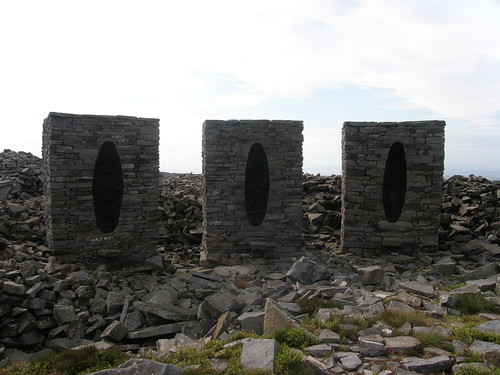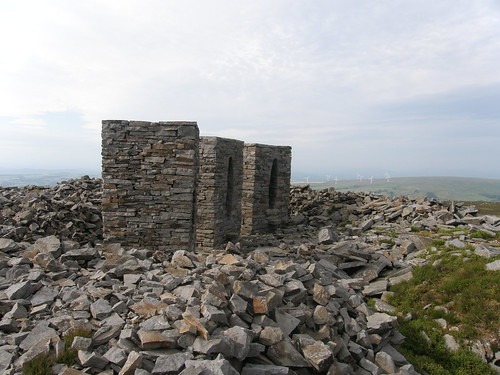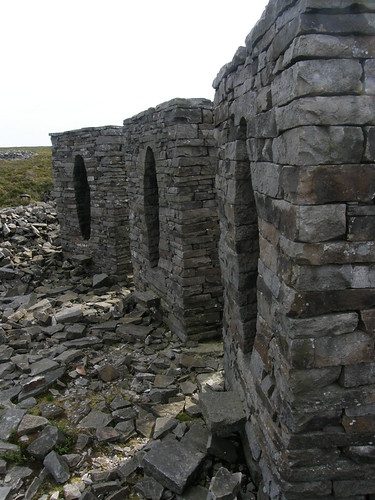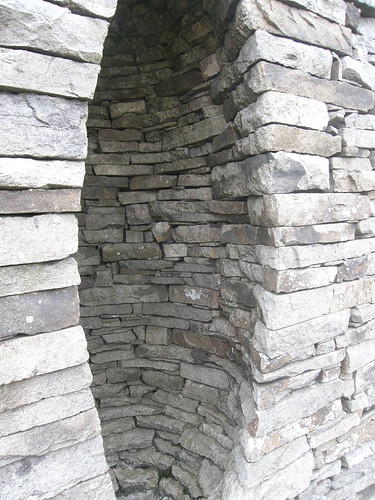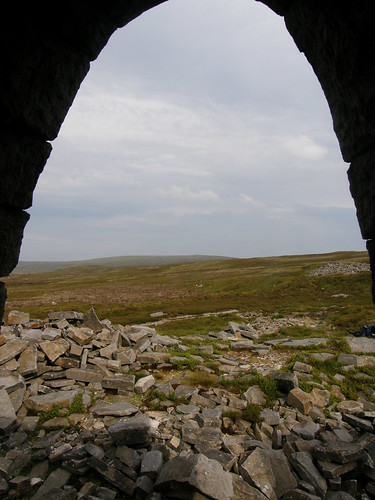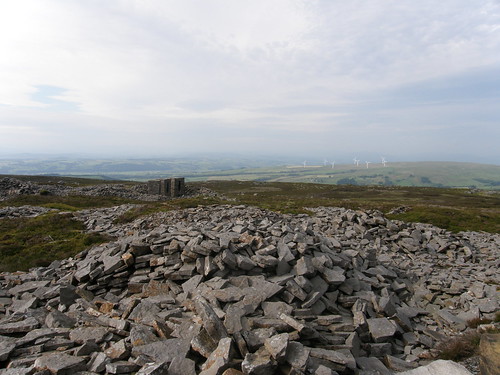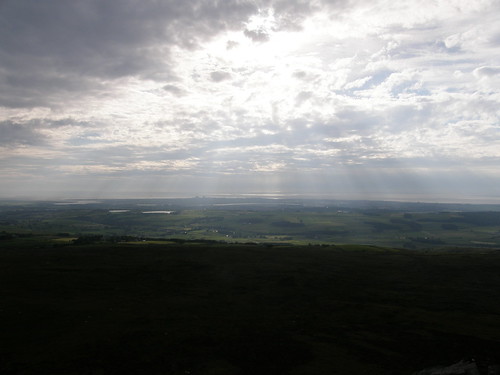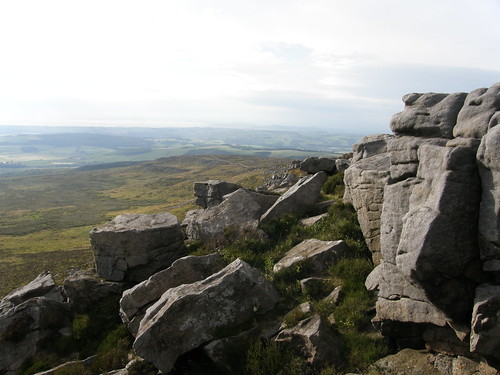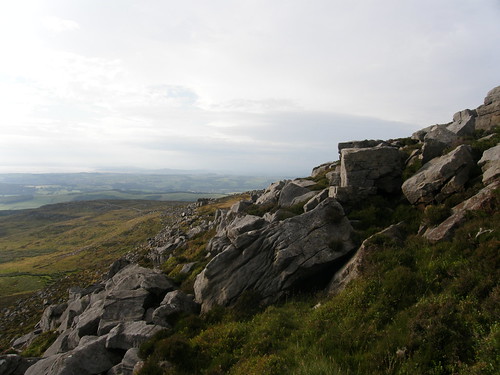
The day after my walk with B to see the avocet chicks. A day, sandwiched between two bright and sunny days, of low cloud and heavy, persistent rain. Perhaps a day to stay indoors. But….the rest of the family were celebrating the jubilee with the village’s various Scout and Guide organisations, a long anticipated window of opportunity; and the forecast suggested that the weather would improve at least a little in the late afternoon; and the week before I’d picked up a second-hand copy of ‘Bird-watching Walks In the Forest of Bowland’ by John Wilson and David Hindle (and with illustrations by the Proper Birder’s daughter). The Forest of Bowland is rather convenient for a quick getaway from work…

The first walk in my new book - ‘In Search of the Mountain Blackbird’ – had immediately caught my eye. It was suggested that pretty much straight from the car I might see stonechat and reed buntings, and I did. Oystercatchers too. And a heron loped away on slow wing-beats up the valley.
Not one but two tracks follow Langden Brook upstream, one only slightly above the stream, the other a little higher up the hillside. For reasons perhaps best described as ‘not thinking it through’ I spurned them both and took a thin trod which seemed to offer to keep me closer to the watercourse. It did. Close to numerous watercourses in fact. The thin trod soon petered out and I found myself plotting a course through a complex web of bogs, dykes, drains, runnels…

It slowed my progress a bit, but it was lovely walking. It also meant that I could watch several sandpipers whirring away from me and flying upstream on rapid pulses of wingbeats followed by gliding with wings held in a downward v.

Every now and again, the heron would reappear and retreat a little further upstream. I also seemed to be following several groups of mallards up the valley. And a quartet of sheep which didn’t have the sense to turn away from the stream and be rid of me.
At one turn in the river, a mallard duck sprang up from almost under my feet, dropped into the river and then proceeded to half-fly, half-swim in a wide arc around me. She was sweeping her wings along the surface of the water, almost as if she was attempting breaststroke. I assumed that this was a broken wing routine and looked briefly for a nest or a brood of chicks, but could find neither.

There was plenty of interest at my feet too, although I wasn’t always sure what I was looking at.

This I thought I knew – heath milkwort.
But there were very similar flowers in both white and pink….

…a related species perhaps? As it turns out, yes…very closely related: heath milkwort, which is usually blue, but in some populations can also be found in white and pink.

As Langden Castle (not a castle at all, but a barn or a former hunting lodge, depending on who you believe) came into view, I spotted another mallard duck and nine chicks, all rooted to the spot, not two yards away, between me and the stream. They were huddled together and hunkered down in a feeble attempt to hide, but still in plain view. They stayed frozen, as if engaged in a game of ‘What time is it Mr Wolf?’, until I pointed my camera their way. Then, as if by some prearranged signal, they all moved in unison. The chicks dropped into the stream….

…and swam in tight formation….

…across a very fast flowing section and under an over-hanging bank where they were well concealed by drooping sedges. The duck flew perhaps a hundred yards upstream and tried to tempt me away with the same swimming/broken wing act as I had been treated to before.

The guide book suggests tarrying for an hour at Langden Castle to bird-watch before heading back down the valley to the car. I had thought about continuing up the valley to Fiendsdale Head and making my way across the moor from there, but that now seemed hopelessly ambitious. An attractive looking compromise looked to be to head up Bleadale instead to give a shorter moorland circuit.

This first entailed fording both Langden Brook and Bleadale Water. Both were a little swollen after the day’s rain, but I managed to get over with only slightly damp feet.

The area around Langden Castle was the haunt of numerous pied wagtails and more reed buntings. Now, as I stopped to photograph two cascades in Bleadale Water, I saw a pair of dippers fly, in opposite directions, from the stream-bank beneath me.

Sadly, I failed once again to capture a sharp image of the dippers….

…but as I watched them, I saw a bird, not too dissimilar from a blackbird, fly from a tree on the far bank to another tree upstream. It had a relatively long tail, I noticed, and….

…a white chest-band. Could it be…

…a ring ouzel? A mountain blackbird!
It was still a dull day, and this is not the sharpest photo ever, but I think that the last time I saw one of these, I was heading into Fisherfield Forest with a tent on my back intending to climb Ruadh Stac Mhor and A Mhaighdean, and that was…well, a long time ago.

At the head of Bleadale the path on the ground went much further right, or west, than the path on the map did. As the path seemed to continue to head in an unhelpful direction, I struck off, heading for the ‘ridge’.

There was some heather bashing and a few peat hags to contend with, but nothing too onerous. The fells around were in and out of the cloud. I was aiming for Totridge, which at times I could see, but which was mostly hidden in mist.

A solitary curlew seemed highly alarmed by my presence and flew around me in wide circles, calling constantly.
Eventually, I was into the cloud myself and began to feel the cold. Even the red grouse had deserted me and only occasional glimpses of meadow pipits sustained my inner bird-watcher.

Looking directly upwards from the summit of Totridge….

…I could see blue sky. Could it be that the weather was going to improve?

Hints of a view began to appear and then, quite suddenly, great vistas opened up.

The hillside drops away steeply from here, and the views were excellent.

One far hillside seemed to hog all of the sunshine for quite some time, although I did eventually get a taste of it myself.
Incidentally, if you decide to come this way, don’t try to follow the path shown on the map, which drops straight from the trig pillar down a fairly steep slope. Stick with the worn path on the ground instead: it follows the edge for awhile before doubling back in the first of several wonderfully graded zig-zags, presumably constructed for the purposes of grouse shooters.

On the way down I was entertained by more red grouse, and curlews, and a solitary hare.

It was getting pretty late, and as I came down through fields, the sheep all followed me, bellowing as they did so: seeing me off. If I’m honest, I find it pretty unnerving.
At Hareden Farm I spotted another dipper and more mallard chicks, before I rejoined Langden Brook for a final for a final kilometre back to the car.

Once again, I found myself following a quartet of sheep. As the spit of land between the stream and the fence narrowed they increasingly found themselves with little room to manoeuvre. One made an ineffectual attempt to jump the fence, catching a horn in the wire in the process. It bucked and pulled to no effect, but it was easy enough for me to unhook the horn and send the sheep on its way.

